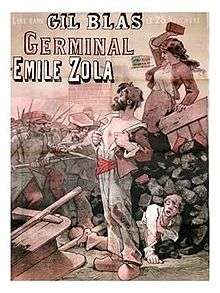Léon Choubrac
Léon Choubrac (17 November 1847 – 5 April 1885), who sometimes signed his drawings with Hope,[1] was a French poster designer and illustrator based in Paris.
Léon Choubrac | |
|---|---|
 | |
| Born | Paris, 17 November 1847 |
| Died | Paris, 5 April 1885 (aged 37) |
| Nationality | French |
| Occupation | Painter, illustrator, draughtsman and poster artist |
With his younger brother Alfred Choubrac, Léon was trained as a classical artist with the painters Charles Doërr and Isidore Pils at the École des Beaux Arts.[1] The Choubrac brothers came very soon to the poster, practicing since 1875 the modern treatment of colors and typography, associated with images thanks to chromolithography.
In the early 1870s, the Choubrac brothers and Jules Chéret (known as "the father of the modern poster") reduced the cost of colour lithography introducing technical advances. Additionally, in 1881 restrictions on bill-posting (affichage) were lifted and eased state control of the media in France.[2][3] In 1884, the Paris city council started to rent out surfaces belonging to the municipality, paving the way for a rapid increase in the production and distribution of advertising posters. Posters with clear colours and dashing images appeared all over town during the vibrant spirit of the Belle Époque.[2]
Léon and Alfred created the Ateliers Choubrac.[4] As an illustrator, he sometimes collaborated with his brother in Gil Blas or the satirical weekly Le Courrier français, among others. Choubrac illustrated several works by Emile Zola. Although Leon died young (1885), his brother Alfred went on to produce an impressive number of posters for Parisian entertainers, theatres, businesses and various commercial products.
Selected works
 Poster for Alcazar d'Hiver (1882)
Poster for Alcazar d'Hiver (1882) Advertising poster of Crème Liebig
Advertising poster of Crème Liebig Advertising poster for a Panorama about the Paris Commune
Advertising poster for a Panorama about the Paris Commune
References
- (in French) Beraldi, Les graveurs du 19e siècle, p.17
- Verhagen, The poster in Fin-de-Siècle Paris, p. 107
- Carter, Karen L. (2010). Unfit for public display: female sexuality and the censorship of fin‐de‐siècle publicity posters, Early Popular Visual Culture, 8:2, 107-124
- (in French) Ateliers Choubrac, Bibliothèque Nationale de France (BNF)
- (in French) Beraldi, Henri (1886). Les graveurs du 19e siècle; guide de l'amateur d'estampes modernes, Paris: L. Conquet
- Verhagen, Marcus, The poster in Fin-de-Siècle Paris: "That Mobile and Degenerate Art", in: Charney, Leo & Vanessa R. Schwartz (eds.) (1995). Cinema and the Invention of Modern Life, Berkeley (CA): University of California Press, ISBN 9780520201125
| Wikimedia Commons has media related to Léon Choubrac. |